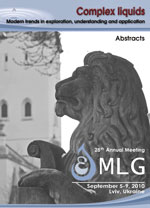Multiscale simulations of the self-assembly of liquid crystalline dendrimers
Jaroslav Ilnytskyi
Multiscale modelling of the self-assembly of liquid crystalline dendrimers (LCDr) in a bulk is performed. As the first stage, molecular dynamics simulations have been carried out to study the structure of a generation three model LCDr in solution on a semi-atomistic level. The model dendrimer is immersed in a mesogenic solvent composed of Gay-Berne particles, which can form isotropic, nematic and smectic-A phases. Markedly different behavior results from simulations in the different phases, with the dendrimer changing shape from spherical to rodlike in moving from isotropic to nematic solvents. The change in structure of the dendrimer is mediated by conformational changes in the flexible chains, which link the terminal mesogenic moieties to the dendrimer core [1,2]. Based on these findings, a coarse-grained simulation model for LCDr is developed. It allows, for the first time, for a successful molecular simulation study of a relation between the shape of a polyphilic macromolecular mesogen and the symmetry of a macroscopic phase. The model dendrimer consists of a soft central sphere and 32 grafted chains each terminated by a mesogen group. The mesogenic pair interactions are modelled by the recently proposed soft core spherocylinder model [3]. Coarse-grained molecular dynamics simulations are performed on a melt of 100 molecules in the anisotropic-isobaric ensemble. The model LCDr shows conformational bistability, with both rod-like and disc-like conformations stable at lower temperatures. Each conformation can be induced by an external aligning field of appropriate symmetry that acts on the mesogens (uniaxial for rod-like and planar for disc-like), leading to formation of a monodomain smectic A or a columnar phase, respectively. Both phases are stable for approximately the same temperature range and both exhibit a sharp transition to an isotropic cubic-like phase upon heating. We observe a very strong coupling between the conformation of the LCDr and the symmetry of a bulk phase, as suggested previously [4,5]. The study reveals rich potential in terms of the application of this form of coarse-grained modelling to the study of molecular self-assembly of liquid crystalline macromolecules.
References
- M.R. Wilson, J.M. Ilnytskyi and L.M. Stimson, J. Chem. Phys. 119, 3509 (2003)
- M.R. Wilson, L.M. Stimson, J.M. Ilnytskyi, Liquid Crystals 33, 1167 (2006)
- J.S. Lintuvuori and M.R. Wilson, J. Chem. Phys. 128, 044906 (2008)
- I.M. Saez and J.W. Goodby, J. Mater. Chem. 15, 26 (2005)
- I.M. Saez and J. W. Goodby, Liquid Crystalline Functional Assemblies and Their Supramolecular Structures 128, 1 (2008)



